Is your home the type that needs its own dam to keep up with water demands, or is water used sparingly in your household? Whether you’re taking a shower or washing the dishes, we all use water in our day-to-day lives, and someone must foot the bill. While water bills aren’t a surprise to many Aussies, the way we’re charged can be.
In this article, we cover everything you need to know about water meters in Australia. So, if you’re wondering where those precious drops are coming from, and how it’s all calculated, then look no further as we dive into the nitty gritty of residential water meters.
Skip ahead to:
- What is a water meter?
- Where is my water meter located?
- How to read your water meter
- Who reads your water meter?
- Understanding your water bill
- Why is my water bill so high?
What is a water meter?
A water meter is an instrument that monitors water consumption at homes and businesses. Similar to a gas meter, water meters record a property’s water usage for billing purposes. Most residential properties will have a water meter installed that measures water usage in kilolitres (KL) or cubic metres (M3) with 1KL and 1M3 equal to 1,000 litres.
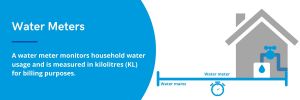
How does a water meter work?
Water meters are built to record water that flows through your property from a particular supply system. There are cogs and spindles inside your water meter that rotate when a specific volume of water has passed through the meter, which is then measured by a handful of dials with numbers on them to reflect the amount of water used.
Types of water meters
Like electricity meters, there are two types of water meters generally found on properties. The most common types are conventional meters, known as analog meters, which vary depending on the brand, model and size. On the other hand, there are more technologically advanced meters which are called digital water meters.
- Analog water meter: Found in most households, these water meters usually have black, white or red numbers displayed on the panel. Some common brands include Elster, GVT, Itron and RMC.
- Digital water meter: Has an attached communication device that allows readings to be recorded remotely, which is then sent directly to the water supplier for billing purposes.
Some properties in certain areas may also be connected to a recycled water meter, which is measured and billed separately from a normal meter.
Where is my water meter located?
Your water meter will usually be located at the front of your house near the nature strip or sidewalk, and will be found at ground level inside a meter box. However, some water meters may be located above ground. For those who live in apartments or townhouses, your water meter will likely be found at the front of your complex, but not all unit blocks will have individual meters for each lot.
How many water meters are at my house?
The amount of water meters at your property will depend on where you live and what type of meters are available in your area. For example, if you live on a recycled water network, you may have an additional water meter that charges you separately to your regular meter. Again, it’s best to check your address with your water supplier or refer to the breakdown of charges listed on your last water bill.
How to read your water meter
Depending on the type of water meter at your premises, you’ll need to open the meter box and lift the lid which shows a sequence of numbers in one colour next to numbers in another colour. If you have an RMC water meter, the numbers in the top display show kilolitres, while the round dials are litres which are read clockwise. In the example below, this Elster water meter reading is 397KL in white and 269L in red.
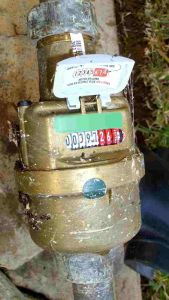
The Itron water meter below reads 477KL and 34L. As you can see, the reading looks much different to the Elster water meter, however both meters have kilolitres displayed in one colour, while the litres are shown in another colour.
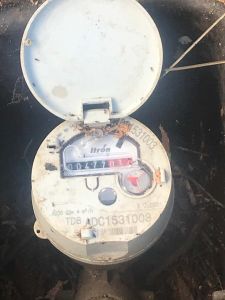
Can you submit a water reading?
Yes, you can submit a water meter reading to your water supplier, provided you’ve given them some details, such as the date of your reading, your unique serial meter number, as well as the reading itself. Most water companies will prompt you to submit a water reading by leaving a card in your letterbox stating they could not access your meter. Water readings can normally be submitted online, over the phone or by posting the self-reading card back to your water supplier.
Who reads your water meter?
Normally, a contractor from your water supplier or retailer will read your meter on an approximate date that’s found on your bill. This usually takes place every three months or quarter, but will vary between water suppliers. Wild weather, locked gates, operational factors and dogs on properties can impact water meter readings, so billing periods may vary from time to time. For instance, one billing period may state 90 days, while another may be charged for 85 days.
Why is my water meter reading estimated?
Estimated water meter readings take place when a meter is inaccessible, due to a locked gate or a dog on the premises. Other reasons may be because the water meter is damaged or faulty and is unreadable, or the contractor cannot locate the water meter. Estimate readings are usually based on the property’s previous water usage, as well as the next bill’s water usage which has had an actual reading take place.
Why is my water meter covered?
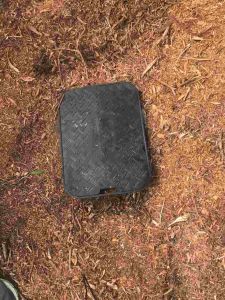
Water meters are covered to prevent them being exposed to weather and other elements. Meters are usually found in an enclosed box that’s underground which is connected to the water mains, allowing water to be supplied directly to your property. Always wear protective gloves when you open a water meter box as they are known to house spiders, snakes and other creepy crawlies.
Understanding your water bill
Whether you’re billed monthly or quarterly, your water bill statement will have quite an extensive breakdown of fees and charges for water usage and supply. Some of the key account information to look out for is:
- Account number: An identification number for your water billing account.
- Bill number or reference: The specific reference ID of your bill.
- Property address: Your water meter’s billing address.
- Bill due date: The payment date your issued water bill is due.
- Billing period: A monthly, quarterly or bi-annually period of your water charges.
- Approximate date of next meter reading: The next estimated date your water supplier will read your meter.
- Total amount due: The total amount payable to your water supplier.
- Previous bill amount: The total amount you paid on your last bill.
- Usage habits: Historical water usage data that compares with current usage.
- Account details: Details of your water meter/s on your property, including readings.
- Fees and charges: A thorough list of costs for water usage and fixed supply charges.
- Payment options: All of the available ways to pay your bill.
If you’d like to get a sense of what the average water bill looks like, then read our guide here.
Why is my water bill so high?
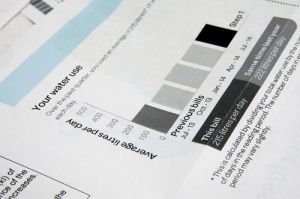
There are various factors to consider if you’ve received a larger than expected water bill. Water leaks can be a common cause of high water bills, however it may be due to water rates increasing in your local area, or lifestyle factors that increase demand for water usage. If a leak is suspected, turn off all water at your premises and avoid using any water for an hour. Check the meter and take note of the dials by jotting down a reading. Come back once an hour has passed to see if the dials have moved.
Additional reading:
How to lower your water bill
So, with a bit of general knowledge on how water meters work, you could be in a better position to cut back those dreaded water costs. Being familiar with your water meter shouldn’t be a hard task, and by recognising when and where you use water the most, you may see a pleasant change in your next bill, provided your household has made the right adjustments.
With the cost of living getting more expensive, it may be time to get proactive about your utilities and seek out ways to not only lower your water bills, but also your electricity bills. If you haven’t compared energy deals in a while, you could be missing out on some serious bargains.
Image credits: Yevhen Prozhyrko/Shutterstock.com, Wikipedia Commons, gmstockstudio/Shutterstock.com


Share this article